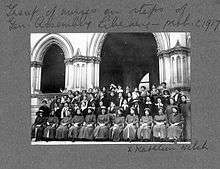New Zealand Army Nursing Service
The New Zealand Army Nursing Service formally came into being in early 1915, when the Army Council in London accepted the New Zealand government's offer of nurses to help in the war effort during the First World War. The heavy losses experienced in the Gallipoli campaign cemented the need for the service.[1]
Formation and First World War
.jpg)


At the start of the First World War, New Zealand had no official army nursing service. In 1911 Hester MacLean had been given the title of 'matron-in-chief' of a proposed military nursing reserve, but despite her efforts (and those of Janet Gillies before her) no service existed by the time New Zealand entered the First World War.[1] New Zealand nurses were motivated by the same sense of duty and patriotism as men who volunteered to serve, but despite over 400 women coming forward in the first two months after the outbreak of war, their offers were refused on the basis that sufficient nurses would be available from England.[2] The New Zealand Defence Minister, James Allen, stated that "until the Mother Country asks us to provide nurses, it would be a presumption to send them."[3]
Prior to the formation of the New Zealand Army Nursing Service, 6 nurses were sent to German Samoa on 15 August 1914.[4] On 25 January 1915, the offer of nurses from New Zealand was finally accepted, and Hester MacLean was asked to select 50 nurses to travel to England. At short notice in March 2015, a dozen nurses were also requested by the Australian government to join a nursing contingent sailing to Egypt and they departed on 1 April. On 8 April 1915 the 50 nurses departed on the SS Rotorua, from Glasgow Wharf in Wellington. They were escorted by Hester MacLean. In choosing the nurses MacLean had drawn from as many hospitals as possible. All of the women were unmarried, with at least six years of nursing experience and their average age was 27.[1]
On arrival in London, the 50 nurses were given orders to sail on to Egypt to tend to the wounded arriving from Gallipoli. Hester MacLearn accompanied them and remained in Egypt to meet further nursing contingents from New Zealand. Along with tending the terrible wounds of the soldiers, the nurses had to treat dysentery, typhoid and heat stroke. They were working long hours in high temperatures, and sometimes in tented hospital accommodations pitched on the sand.[2][4]
Lottie Le Gallais, a nurse in a later contingent who served aboard the hospital ship Maheno wrote "Terrible, terrible wounds. The bullets aren’t so bad but the shrapnel from exploding shells is ghastly. It cuts great gashes, ripping muscles and bones to shreds. Thirty-nine men have died on board so far and every one suffered great pain and discomfort."[5]
By August 1915 a second contingent of nurses from New Zealand arrived in Egypt, and a third contingent of 11 nurses had departed aboard the hospital ship Maheno.
References
- 1 2 3 "New Zealand Army Nursing Service in the First World War - New Zealand Army Nursing Service | NZHistory, New Zealand history online". www.nzhistory.net.nz. Retrieved 2016-02-17.
- 1 2 "In coats of grey and scarlet - New Zealand nurses at war". www.nursingreview.co.nz Nursing Review: New Zealand's Latest Nursing News on, Health, Education, Nursing, Clinical, Mental health, Aged care, Maori health, Enrolled nursing and Professional development. Retrieved 2016-02-17. line feed character in
|website=at position 24 (help) - ↑ "Anzac nurses: fighting for the right to care for their lads". www.nursingreview.co.nz Nursing Review: New Zealand's Latest Nursing News on, Health, Education, Nursing, Clinical, Mental health, Aged care, Maori health, Enrolled nursing and Professional development. Retrieved 2016-02-17.
- 1 2 "Chapter V. — New Zealand Army Nurses | NZETC". nzetc.victoria.ac.nz. Retrieved 2016-02-17.
- ↑ "Lottie Le Gallais Great War Story | NZHistory, New Zealand history online". www.nzhistory.net.nz. Retrieved 2016-02-18.